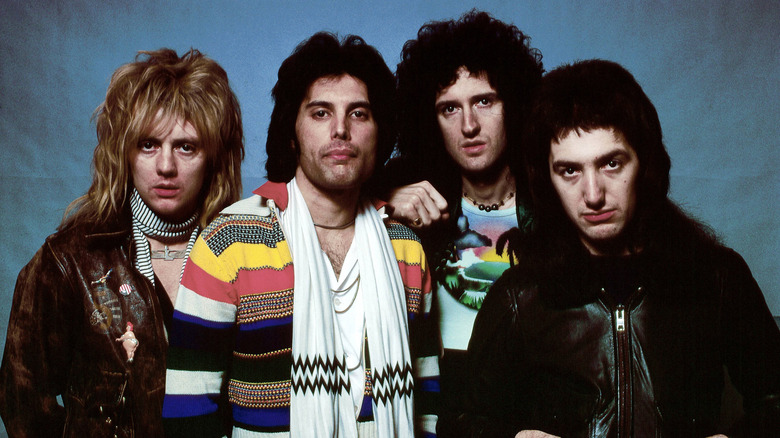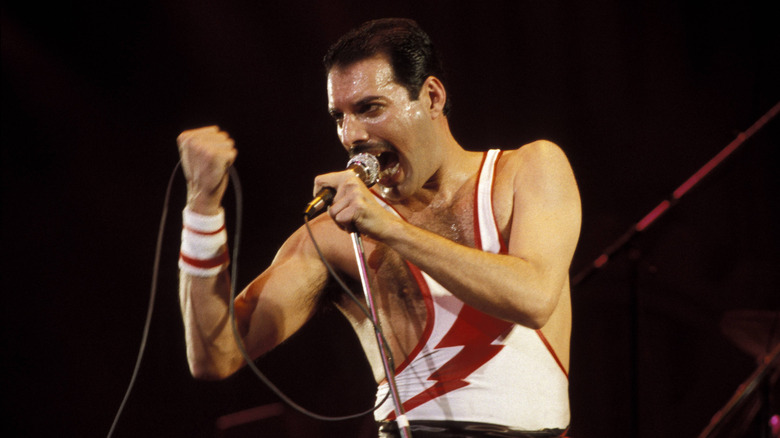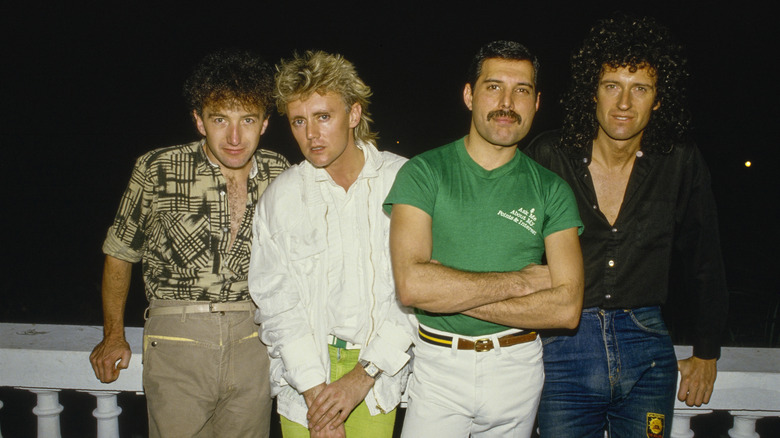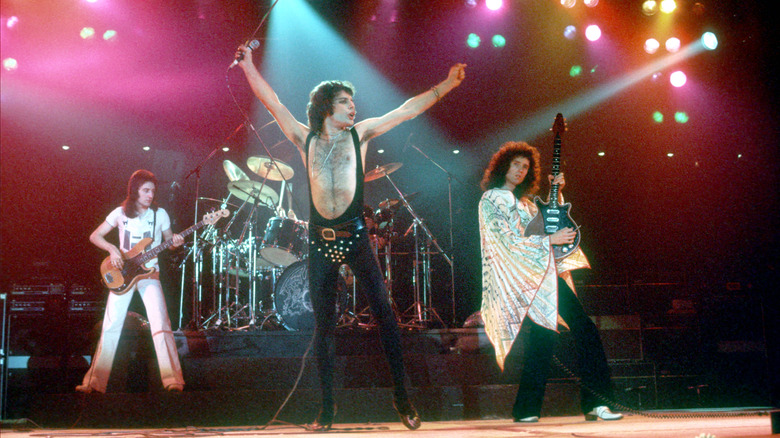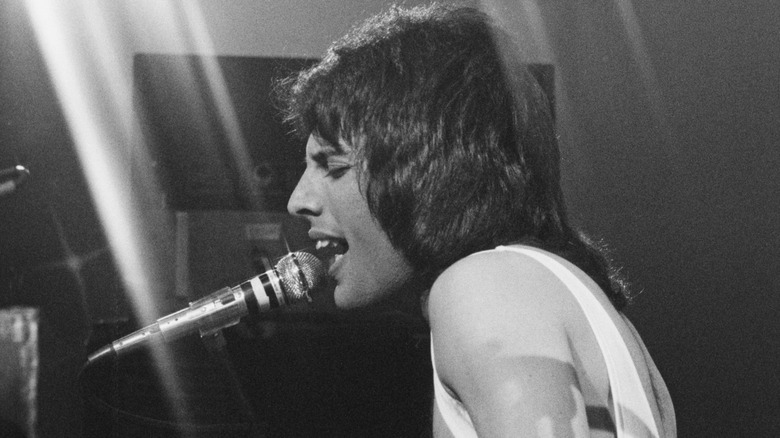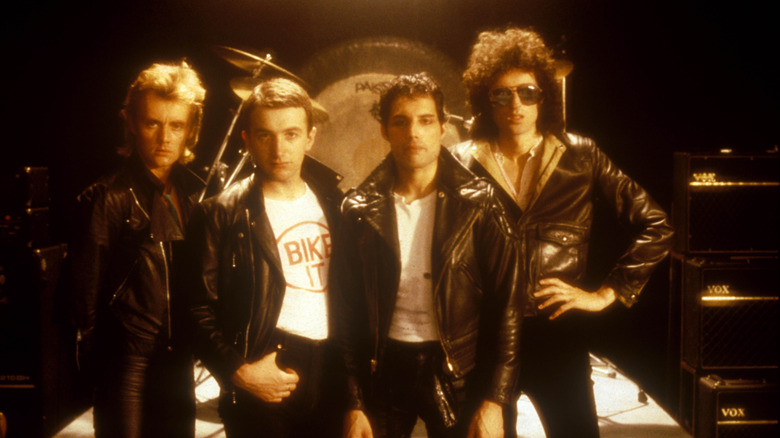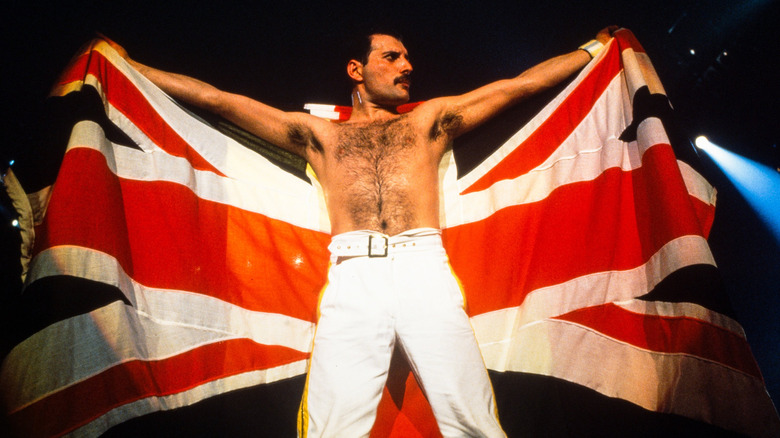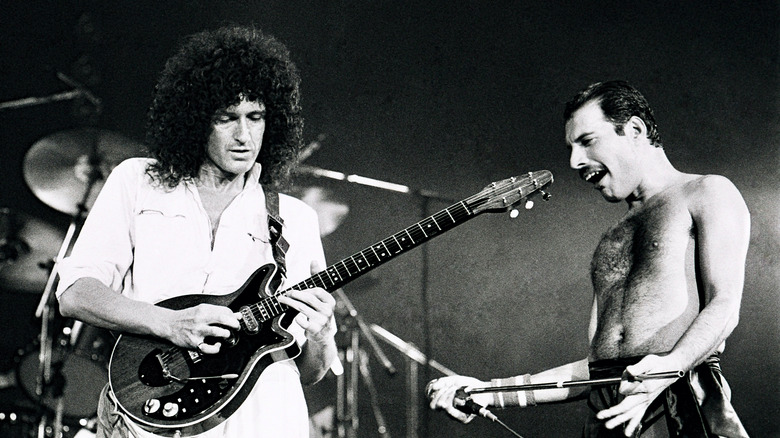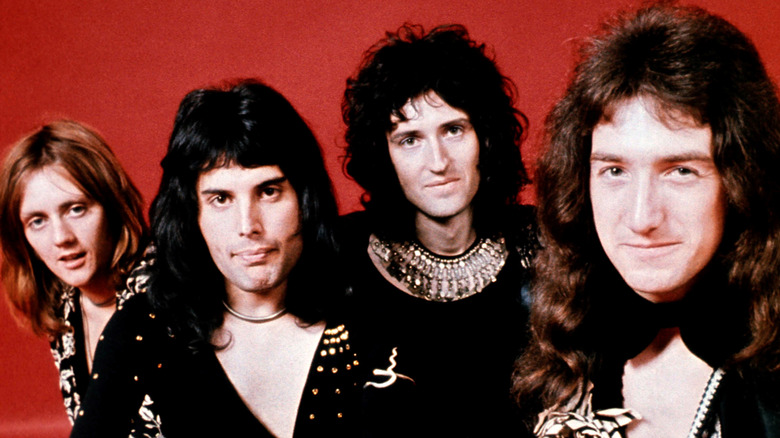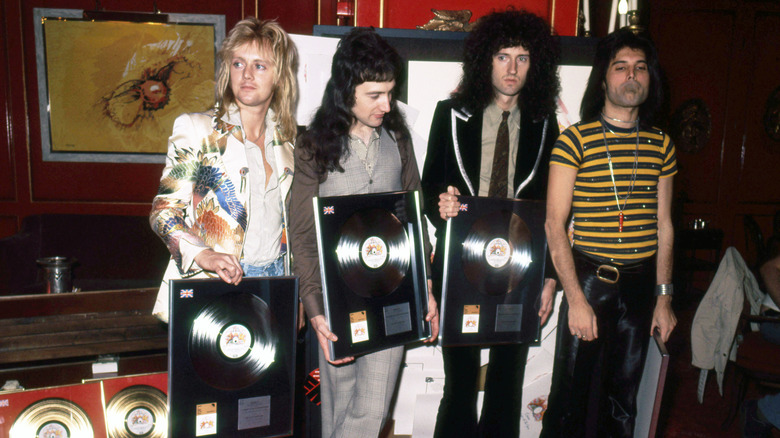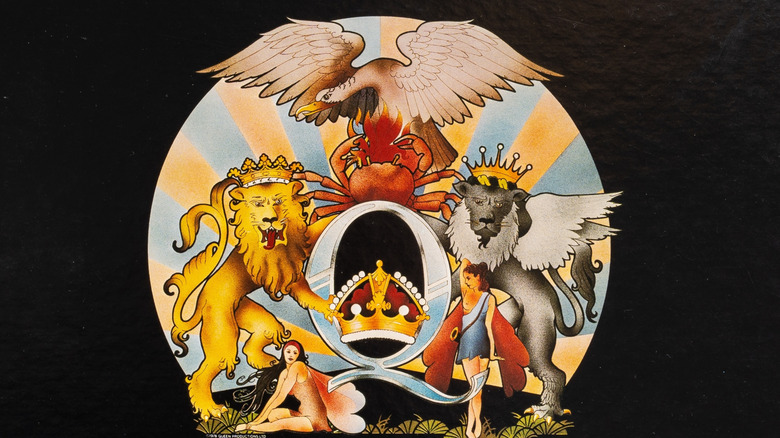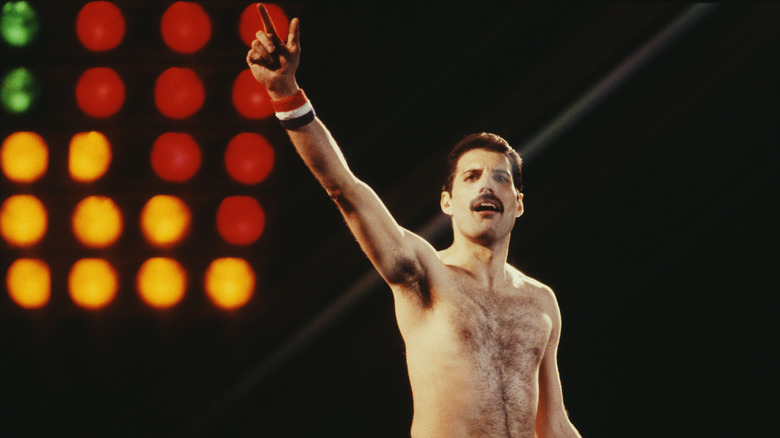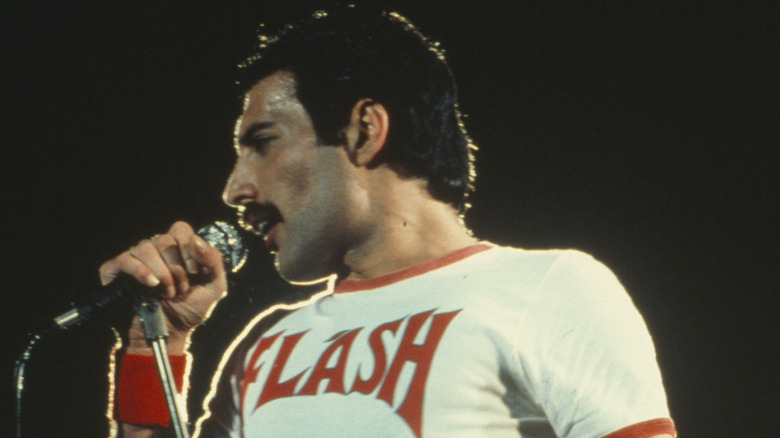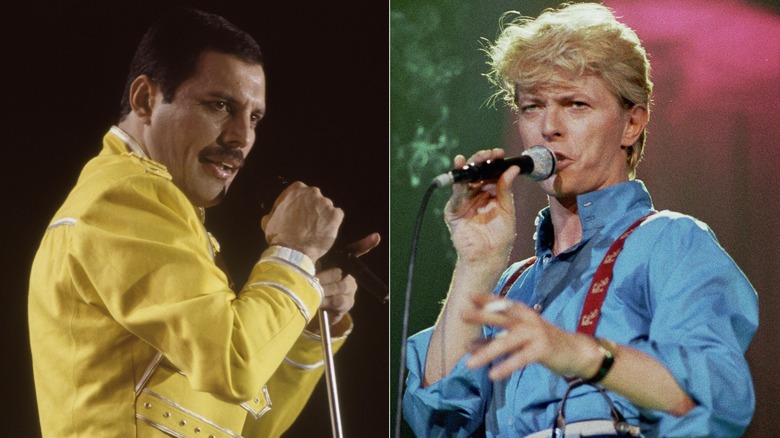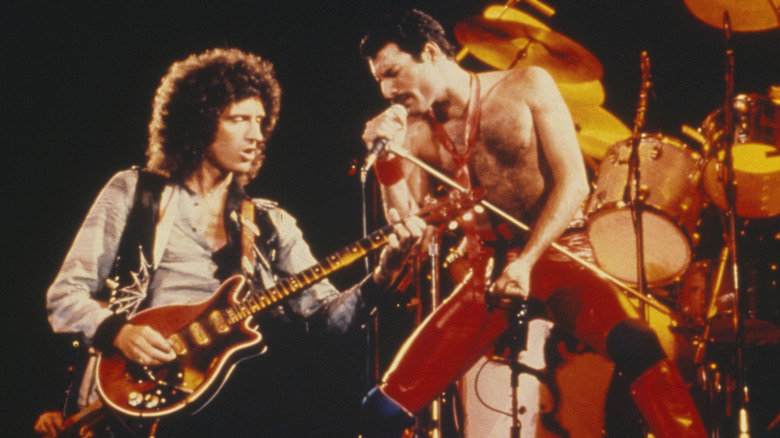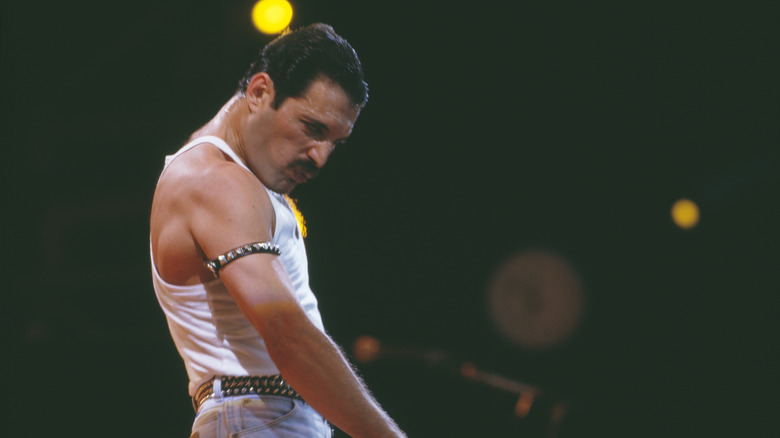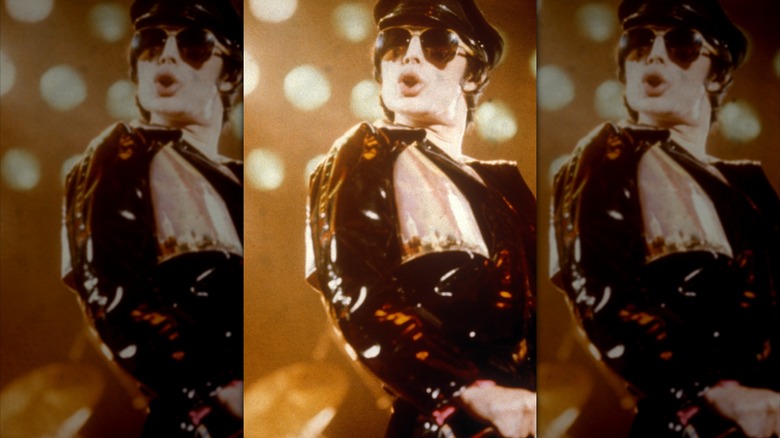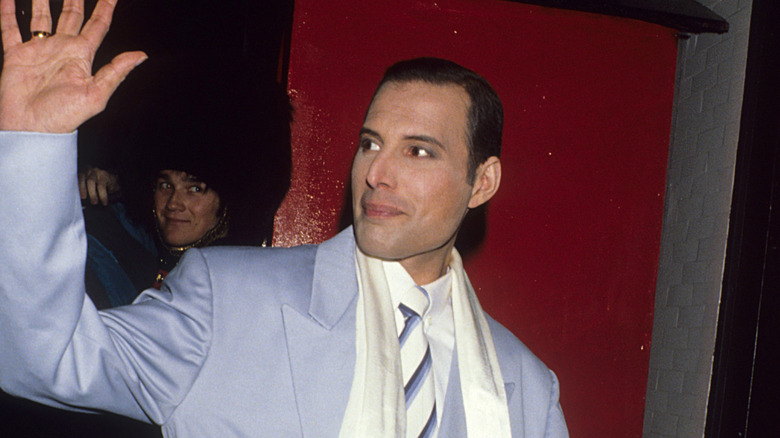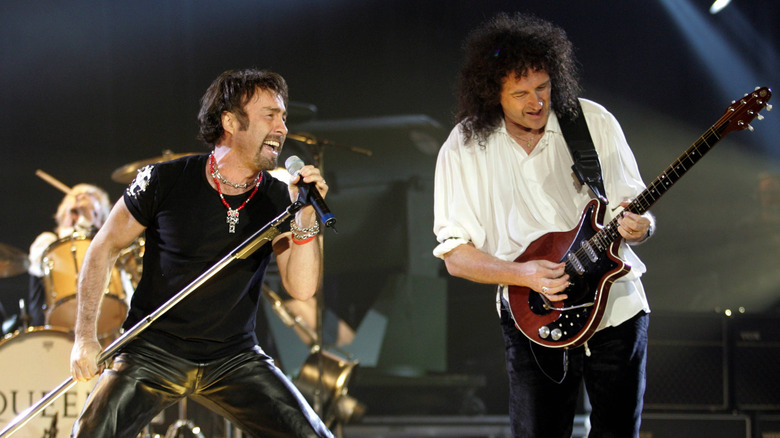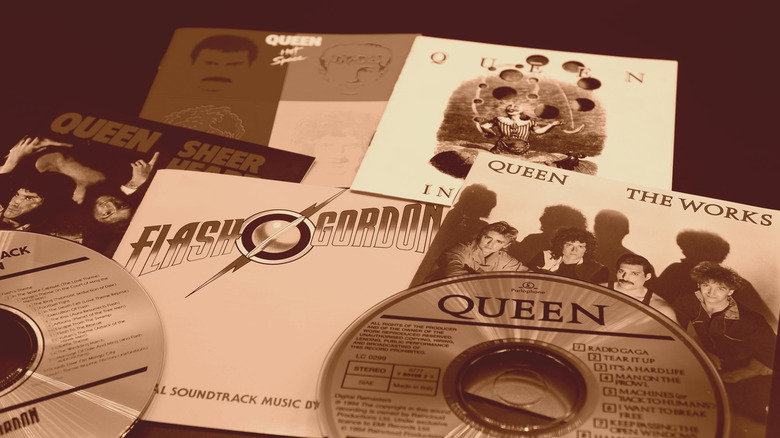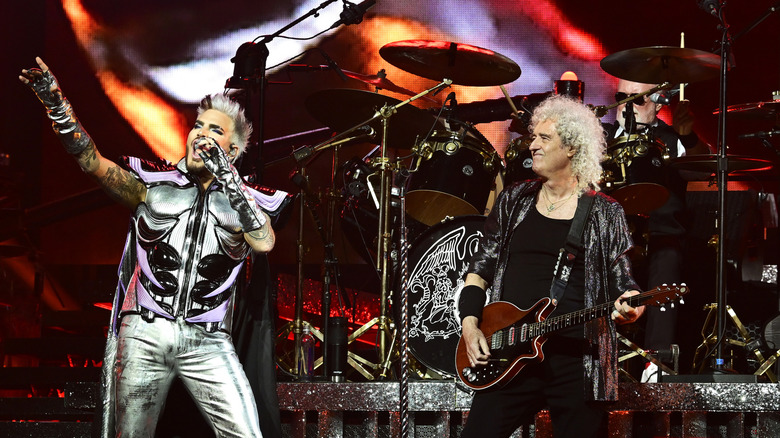Why There Will Never Be Another Band Like Queen
In late 1960s London, guitar player Brian May and bassist/singer Tim Staffell formed a band they called Smile, eventually enlisting drummer Roger Taylor. A friend of Staffell, Zanzibar-born Farrokh Bulsara became an early fan of the band. Smile hovered on the cusp of success that never quite arrived, and Staffell eventually bailed to join another band.
While May and Taylor considered packing it in, Bulsara — who called himself Freddie — was waiting in the wings, and talked his way into auditioning to be the band's new singer. Adding John Deacon on bass and renaming the band Queen, Bulsara changed his name to Freddie Mercury, and the rest is history. Queen went on to become one of the most popular rock bands in history, selling more than 300 million albums over the course of a career cut short in 1991 by Mercury's AIDS-related death, only to be resurrected decades later with a powerful new singer.
A 2022 poll in the U.K. asked fans to vote for the greatest rock band of all time, and Queen handily won that honor. With the band's timeless music still embedded in the fabric of pop culture, there are many reasons why there will never be another band like Queen.
Freddie Mercury's voice was like no other
Queen has always been more than simply a sum of the band's parts, yet arguably the most crucial of those was the distinctive vocals of flamboyant Queen front man Freddie Mercury. Possessing a multi-octave range and an operatic flair, Mercury's influence is felt throughout Queen's expansive catalogue.
In fact, scientists revealed what made Mercury's voice so incredible, courtesy of a 2016 scientific study published in the journal Logopedics Phoniatrics Vocology and undertaken by professors at Palacký University Olomouc in the Czech Republic. An acoustic analysis demonstrated that his voice could transition from 92.2 Hz to 784 Hz, comfortably spanning three octaves. The study also found that Mercury's vocals were bolstered by subharmonics, an effect that occurs when the throat's ventricular folds and vocal folds vibrate simultaneously — a sound typically linked to Tuvan throat singers, who can create up to four different pitches at the same time.
How Mercury learned to do that is anyone's guess, yet the uniqueness of his voice was ultimately the result of a variety of factors, some of which were within his control and some not so much. There's been much speculation that Mercury's noticeable overbite was a contributing element. Dental X-rays indicate that Mercury had four extra incisors wedged within his top teeth, a condition known as hyperdontia. While Mercury disliked his overbite and often hid his teeth whenever possible, he never had the condition corrected; the real reason Mercury never fixed his teeth was that he feared that he could ruin the voice that made him a star.
Queen is the only band in which each member wrote multiple No. 1 hits
Queen racked up a lot of hits: during the course of a career spanning from the early 1970s until Freddie Mercury's 1991 death, the band spent more weeks on the charts than any other group in history, even legendary rock band The Beatles. Unlike many bands, in which songwriting duties are handled by one or two members, each of Queen's four members contributed songs to the Queen canon, and each wrote multiple songs that soared to No. 1 in various parts of the world.
Mercury, of course, was at the top of that particular list, writer of such No. 1 hits as "Bohemian Rhapsody," "Crazy Little Thing Called Love," "Killer Queen," and "Somebody to Love." Guitarist Brian May wrote "We Will Rock You" and "Flash," while bassist John Deacon composed "Another One Bites the Dust," "You're My Best Friend," and "I Want to Break Free." Drummer Roger Taylor had a direct hand with three hits in the U.K.: "These Are the Days of Our Lives", "Innuendo," and "Under Pressure."
The band made history for the members' combined songwriting in 2003, when Queen became the first band to ever be inducted into the Songwriters Hall of Fame. "An award for songwriting is probably of more importance than an award just for selling records," said Taylor in his acceptance speech. "It's all about the creative process right from the very beginning ..."
There has never been a single like Bohemian Rhapsody
Of all the various Queen hits, the Freddie Mercury-written "Bohemian Rhapsody" stands alone as the band's magnum opus. That said, "Bohemian Rhapsody" defied the conventions of what a hit single was supposed to be. Infused with operatic elements, multiple sections, and weird lyrics ("Scaramouche, Scaramouche, will you do the Fandango?"), the song was also far lengthier than conventional wisdom dictated at the time.
It all began when Mercury showed up at a recording studio carrying scraps of paper with lyrics and ideas, then sat down at the piano and banged out a preliminary version. What were originally three different songs were ultimately combined into one epic track. "It was recorded in pieces, as I think everybody knows," Brian May explained in a 2021 interview with Guitar World. "We would rehearse and record. We'd do it until we got it right. The various bits were put together."
Creating the stunning choral harmonies, however, pushed the limits of 24-track analog recording to the brink, with 160 different vocals overdubbed to the point that the tape had worn so thin it was practically translucent. As May recalled during a 2021 appearance on NPR's "Fresh Air," he, Mercury, and drummer Roger Taylor would sing in three-part harmony, over and over again. "And we would sing one line until we felt it was right ... Then we'd move on and double track it and double track it again."
Queen's signature hit almost wasn't released as a single
When "Bohemian Rhapsody" was completed, all members of Queen realized they'd created a singularly unique work of art. Clocking in at just under six minutes, not only was the song considered far too long to receive radio play, the band's label was also hesitant to release it as the debut single from "A Night at the Opera." "I think we always knew that 'Bohemian Rhapsody' was, in a sense, a long shot: it would either get received extremely well or be dismissed immediately as being too complex and too long," Brian May told Classic Rock.
A decision was made to roll the dice. "Bohemian Rhapsody" was released as the album's first single, gambling that Mercury's ambitious mini-rock opera would captivate fans the way it had staffers at EMI who'd heard it. "I was standing at the back of the control room and you just knew that you were listening for the first time to a big page in history," the song's producer, Roy Thomas Baker, told Sound on Sound. "Something inside me told me that this was a red letter day, and it really was."
Ultimately, the success of "Bohemian Rhapsody" speaks for itself. The song spent nine weeks atop the U.K. charts upon its 1975 release, and five more after the death of Freddie Mercury. "Bohemian Rhapsody" also holds a spot as the third highest-selling single of all time in the U.K.
Queen successfully spanned several genres
Looking back at Queen's catalog in its entirety, it's clear that the band was not easily categorized. Queen's first two albums could easily be written off as heavy prog-rock, yet "Keep Yourself Alive," from the self-titled debut, demonstrated Queen could rock out with the best of them.
Queen's third album, "Sheer Heart Attack," spawned "Killer Queen," which shared more with nightclub cabaret than rock. Its follow-up, "A Night at the Opera," featured the band stretching out even further to display even more diversity, from opera to rock. The next album, "A Day at the Races," delivered both the pop hit "Somebody to Love" and the flat-out rocker "Tie Your Mother Down."
With "News of the World," Queen set the standard for rock anthems with the one-two punch of "We Will Rock You" paired with "We Are the Champions," while the next album, "Jazz," encompassed hard rock ("Fat-Bottomed Girls"), the weirdly wonderful but uncategorizable "Bicycle Race," the musical oddity "Mustapha" (with Freddie Mercury singing in Persian and Arabic), and "Don't Stop Me Now," which would not have been out of place in a Broadway musical. The 1980 album "The Game" brought about a whole new genre with Queen delving into funk with "Another One Bites the Dust." Meanwhile, "A Crazy Little Thing Called Love" was a straight-out homage to 1950s rockabilly. "I've always loved Queen," Muse drummer Dom Howard told Forbes. "I've loved how their musical diversity has gone over all the place."
Queen's live concerts were stunning spectacles
There are few front men in rock history with the flamboyance and stage presence of Freddie Mercury. While Queen's albums were the result of meticulous multitrack recording, the group's live shows showcased Mercury's dynamic stage presence. This dated back to the band's earliest days, such as a now-legendary 1974 concert at London's Rainbow Theatre that was highlighted by an incendiary performance of "Stone Cold Crazy," which featured Mercury strutting around the stage while Brian May soloed ferociously.
A decade later, Mercury had cemented his status as one of rock's most dynamic front men. That was certainly on display during the 1985 Rock in Rio festival, arguably among Queen's most legendary live performances, as it played for an audience of 300,000 in what was one of the biggest rock festivals ever held. As Mercury said in an interview at the time, he approached that show just as he would any other. "Well, it's mind-boggling you know, and to me I just ... it's like a housewife, to be honest, just go on there and do my job and then come home," he said.
Brian May's guitar sound can never be replicated
A solo by Queen guitarist Brian May is instantly recognizable for its singular tone and unique sound. While May's technique on the instrument is a key reason for this, there are other major factors contributing. Chief among these is his guitar, the Red Special, a handmade guitar that teenage May built with his father, using repurposed wood from a fireplace mantle. "At that time, we thought it would be interesting to make a guitar, seeing as I couldn't afford a Stratocaster," May told Guitar Player.
Given that neither May nor his father had built a guitar before, there was a lot of trial and error involved. "We made everything totally from scratch with hand tools," May explained. The sound it produced was unlike any other guitar. "It was different from a Strat: it's warmer. It's different from a Gibson: it's got more top-end. It's got a very wide sound."
Also contributing to May's guitar sound is the fact that he doesn't use a standard guitar pick, instead utilizing a British sixpence coin. "Sixpences are very soft metal, which doesn't hurt the guitar strings, but if I turn that serrated edge at an angle to the string, I can get that kind of articulating, percussive consonant sound — I call it graunch," he told The Guardian.
Queen's distinctive harmonies were beyond unique
While Freddie Mercury's lead vocals and Brian May's guitar work were each distinctive, so too were the harmonies that the two produced along with drummer Roger Taylor. That wholly unique sound of Queen's backing vocals was the result of a very specific process, as detailed by Nick Brae in a 2015 paper for the Journal on the Art of Record Production, titled "The Development of the 'Epic' Queen Sound."
To achieve those harmonies, three members of the band — Mercury, May, and Roger Taylor — would simultaneously sing each note of a three-note chord. Each chord would be recorded multiple times, so that what would typically have been a three-part harmony could feature as many as 36 voices, essentially transforming those three voices into a choir. Then there were the individual tones of each singer, with May's voice smooth, Mercury's powerful, and Taylor's somewhat thinner.
Nowhere can the iconic Queen harmonies be heard best than in the operatic middle section of "Bohemian Rhapsody." As producer Roy Thomas Baker told Sound on Sound, overdubbing all those harmonies was a painstaking process that could not be rushed. "That section alone took about three weeks to record, which in 1975 was the average time spent on a whole album," he recalled.
Queen morphed from prog-rock to mainstream hitmakers
When Queen's self-titled debut album was released in 1973, it would have been very easy to lump the band into that era's burgeoning prog-rock scene, among the likes of Yes, Genesis, and King Crimson. And while the band moved on in various musical directions over the years, prog was certainly at the band's core. Perhaps the apotheosis of that sound was the group's second album, "Queen II," and the six-minute-plus prog epic "March of the Black Queen."
It wasn't until the third album, "Sheer Heart Attack," that Queen logged what would become the first of many hits on the American Billboard charts, with "Killer Queen" hitting No. 12 on Billboard's Hot 100 and remaining on the chart for 19 weeks. It would be nearly five years until Queen landed its first No. 1 on that chart, with "Crazy Little Thing Called Love" spending four weeks in the top spot. Eight months later, another track from "The Game" album gave the band its second No. 1, "Another One Bites the Dust."
Interviewed by Forbes, Queen drummer Roger Taylor discussed the band's musical evolution. "It wasn't like a series of records coming out in the same style; there was a lot of variety ..." he said. "It went from hard rock to almost rockabilly to a little bit funky to grandiose, it covered a lot of ground ..."
The iconic Queen logo was designed by Freddie Mercury
Any rock band worth its salt has its own logo — The Rolling Stones' iconic lips-and-tongue logo, for example, is among the most identifiable images in the world. Queen also has a logo, which famously appeared on the cover of the band's iconic "A Night at the Opera" album, and then in a somewhat altered form on the album cover of the follow-up, "A Day at the Races."
The logo was designed by none other than front man Freddie Mercury himself, utilizing the skills he attained in his previous incarnation studying graphic design and illustration at London's Ealing Art College. Mercury's design — known as the Queen crest — is modeled after a royal coat of arms, but what does the Queen crest mean? Well, Mercury combined the zodiac signs of all four band members: two lions (representing Leo) for John Deacon and Roger Taylor, a crab (Cancer) for Brian May, with Mercury symbolizing his sign, Virgo, with a pair of winged fairies. At the center sits a regal crown within an ornate letter Q, while an enormous bird — a mythical phoenix — spreads its wings above the entire thing.
One of Queen's singles remains a staple at sporting events
The standout track from Queen's 1977 "News of the World" album, the combo single "We Will Rock You/We Are the Champions" became a concert standard, while also emerging as a sing-along anthem at sporting events worldwide. "The story we've been told is that Brian [May] and Freddie [Mercury] said, 'Why don't we write our own anthems?'" record exec Dominic Griffin told Billboard. "So Brian wrote 'We Will Rock You,' Freddie wrote 'We Are the Champions,' and they started finishing their shows with those."
As May told the Daily Mail, they hatched the idea of generating an anthem after a concert ended and the audience spontaneously began singing "You'll Never Walk Alone," which had become a popular at British soccer games. Realizing that fans were eager to participate, they decided to come up with a song that fans could sing along with. "In the end we decided not to fight it, but rather to enjoy and even encourage it," May added. "'We wanted to get the crowds waving and singing. It's very unifying and positive. People love it because it's so uplifting."
So prevalent is the single in the world of sports that "We Will Rock You/We Are the Champions" became the official theme song for the 1994 FIFA World Cup. Meanwhile, the single also returned to the charts in France during the 1998 FIFA World Cup, rocketing all the way to No. 10.
Queen recorded a soundtrack album for a sci-fi movie
Thanks to the monumental success of 1977 blockbuster "Star Wars," science fiction was all the rage in the 1970s. When plans were hatched for a big-budget space opera based on classic comic strip "Flash Gordon," Queen was tapped to create the soundtrack.
As guitarist Brian May recalled when interviewed for "The Guitar Greats," he and the other members of Queen were eager to embrace the challenge of writing music for a movie. "It was in our minds that we would be up for writing a soundtrack if the right one came along," May recalled. "We'd been offered a few, but most of them were where the film is written around music, and that's been done to death — it's the cliché."
Looking back at the experience while appearing on the "Life After Movies Web Show," May said he balked against the typical scenario, in which an orchestral score would be used throughout while Queen would simply punch out a few songs to be played at certain points (typically over the closing credits). May insisted that if Queen was going to create a soundtrack, it would be a full soundtrack. "If we could actually do this in a kind of rock style, it could really break some barriers down ... we would be an organic part of the film," he said.
Queen scored a huge hit by collaborating with David Bowie
One of Queen's most durable hits came about through an unexpected collaboration with David Bowie. Released in late 1981, "Under Pressure" spent 16 weeks on the Billboard Top 100, peaking at No. 29, and all thanks to a chance meeting. While Queen recorded its "Hot Space" album at Mountain Studios in Montreaux, Switzerland, Bowie was there recording the title track for his film, "Cat People." As Queen drummer Roger Taylor recalled in an interview for "Is This The Real Life? The Untold Story of Queen," Bowie dropped into their recording studio, and they began jamming on different cover songs. "In the end, David said, 'This is stupid, why don't we just write one?'" Taylor recalled.
They did, embarking on an epic recording session lasting nearly 24 hours, with the musicians propelled by a few bottles of wine and some other substances. "There was so much blow," recalled producer Reinhold Mack. According to guitarist bassist John Deacon, Bowie led the session, and even came up with the propulsive bass line that opens the song. "It took me a certain amount of time to learn it," he said.
However, the truth about Mercury's friendship with Bowie was complicated, with Mercury miffed when Bowie took the lead. May told Mojo Magazine (via Biography), "Freddie and David locked horns, without a doubt ..." May told Mojo (via Biography). "But that's when the sparks fly and that's why it turned out so great."
The massive success of Another One Bites the Dust led Queen to alter its sound
Queen's 1980 album "The Game" was significant for bringing the band its first two (and only two) No. 1 U.S. hits, "A Crazy Little Thing Called Love" and "Another One Bites the Dust." Written by bassist John Deacon, the latter song was inspired by dance-funk outfit Chic — liberally borrowing its distinctive bass line from Chic's "Good Times" — and became Queen's first-ever dance hit.
The response to Queen's newfound popularity on dance floors did not go unnoticed by the band and its label. As a result, the influence of "Another One Bites the Dust" can be heard in Queen's subsequent album, "Hot Space," which was dominated by synthesizers and danceable grooves.
While Queen's new sound expanded its fanbase considerably, it also alienated the hardcore American rock fans who'd propelled it to the top. "They thought it was 'not very rock 'n' roll,'" Brian May observed for "Is This The Real Life?" Speaking with Rhythm Magazine, drummer Roger Taylor concurred. "We made a couple of strange choices for albums — we went down a sort of funk avenue with the slight dance angle, and that was everything that our U.S. followers hated," he said. "I felt at the time that we were going too far down that road, but because we'd had a huge hit with 'Another One Bites The Dust,' we thought, 'Oh, this is our new direction,' but it wasn't really us."
One of the band's all-time greatest performances was viewed by more than a billion people
By 1985, Queen's glory years appeared to be in the past. The band's synth- and dance-fueled 1982 album "Hot Space" did not resonate with fans (although the dance single "Body Language" hit No. 11 on the Billboard Hot 100). Its 1984 follow-up, however, found the band on better footing, thanks to songs like "Hammer to Fall," "I Want to Break Free," and "Radio Gaga" (the latter two hitting No. 45 and 16, respectively).
Yet few would have guessed that when the band took to the stage at the Wembley Arena during the Live Aid concert, it would not only steal the show from a who's who of rock icons, but would also deliver an incendiary performance that would ultimately define it — viewed by 72,000 at the venue, and a staggering 1.9 billion watching on television.
Guitarist Brian May attributes the still-iconic stature of that performance solely to front man Freddie Mercury. "That was entirely down to Freddie," May said, via Rolling Stone. "The rest of us played okay, but Freddie was out there and took it to another level."
Freddie Mercury was an LGBTQ trailblazer
During its 1970s heyday, glam rock blurred traditional notions of gender, with the likes of David Bowie, Marc Bolan, and others reveling in androgyny. Freddie Mercury certainly fit that template, yet remained ambiguous about his sexuality. He had romantic relationships with both men and women (particularly his longtime girlfriend, Mary Austin), but never publicly came out as gay. However, as Brian May observed in a 2017 interview with The Times, he witnessed the singer's evolving sexuality firsthand. "It was fairly obvious when the visitors to Freddie's dressing room started to change from hot chicks to hot men," May quipped.
In hindsight, Mercury certainly wasn't hiding his sexuality. For example, his leather-outfitted 1980s stage attire would have been right at home in the gay bars that he reportedly frequented. And that was the dichotomy of Mercury's stardom. To those in the know, he was a gay icon.
Homophobic male rock fans during the 1970s, however, were content to ignore the obvious and focus on Queen's hard-rocking music, while Mercury was hesitant to place labels on himself. "It wasn't just about sexuality with him; it was about his whole identity and the flamboyant persona he projected on stage, which is one of the main things Queen are known for," PinkNews editor Ryan Butcher told BBC News. Despite Mercury's own ambiguity, he was voted the U.K.'s greatest gay icon in a 2024 poll.
Freddie Mercury was the first rock star to publicly reveal his HIV diagnosis
Freddie Mercury was officially diagnosed with AIDS in 1987. However, reports indicated that he first sought medical assistance as early as 1982. In any case, he kept the diagnosis a secret for years, until its ravages began to become apparent enough that the British tabloids began to speculate that the increasingly gaunt singer was ill.
In 1991, Mercury made history when he publicly confirmed the rumors that had been spreading like wildfire. "Following the enormous conjecture in the press over the last two weeks, I wish to confirm that I have been tested HIV-positive and have AIDS," he said in a statement (via the Los Angeles Times). "I felt it correct to keep this information private to date in order to protect the privacy of those around me. However, the time has now come for my friends and fans around the world to know the truth, and I hope that everyone will join with me, my doctors and all those worldwide in the fight against this terrible disease."
With that announcement, Mercury made history as the first rock star to go public with a diagnosis of AIDS. There was little time for that to sink in, though; the following day, he died at the age of 45.
Queen attempted a comeback with ex-Bad Company singer Paul Rodgers
After the surviving members of Queen paid tribute to late front man Freddie Mercury at a star-studded 1992 tribute concert, they spent the next decade-plus pursuing solo projects. Brian May, John Deacon, and Roger Taylor continued to periodically perform together, until Deacon announced his retirement from all things Queen-related in 1997.
May and Taylor then enlisted keyboardist Spike Edney for a series of "Queen +" concerts, with a variety of different singers filling in for Mercury (a list that ranged from British pop stars George Michael and Robbie Williams to Italian opera legend Luciano Pavarotti). Those shows ultimately led the band to join forces with former Free/Bad Company singer Paul Rodgers for a 2005 tour. The iteration known as Queen + Paul Rodgers quickly snowballed. "It grew from being a European tour into a worldwide tour, which took two years to get around," Rodgers told Vintage Rock in 2007. "It took us all by surprise and it's great."
Queen parted ways with Rodgers in 2009, with the singer admitting he wanted to get back to making his own music rather than remaining in Mercury's shadow. "By the time I'd toured with the guys and done all that, I realized what it was like to stand in Freddie's shoes," he recalled in an interview with TalkShopLive, "and it was not an easy gig."
Queen sold its catalog for a staggering sum
As rockers of the 1960s and '70s aged into their 60s and 70s, many of them decided to cash out by selling their music catalogs. Artists such as Pink Floyd, Bruce Springsteen, and Bob Dylan have all sold their catalogs for eye-popping sums, while the catalogs of David Bowie and Michael Jackson were sold posthumously. Jackson's catalog, in fact, sold for a staggering $600 million, yet that was small potatoes when compared to the deal made when Sony purchased the Queen catalog.
In 2024, when the surviving Queen members sold the catalog, history was made when Sony plunked down nearly $1.3 billion. The deal went through after an intense bidding war, and the next-highest bidder backed away after an offer of $900 million.
Even though the band no longer earns money from its recordings, the members oversaw a restoration of the first Queen album, with a six-disc box set unveiled in late 2024. "We recently sold our wares to Sony, of course, so we're clearly not doing this for the money, " May told Mojo of working on the project. "When I pop off from this planet, I would like to know that I've done my best on anything that I ever touched."
A Hollywood biopic about the band was an Oscar-winning box-office blockbuster
Hollywood has turned to famous musicians for big-screen biopics plenty of times, with examples ranging from the Johnny Cash-inspired "Walk the Line" to dramatizing Tina Turner's life in "What's Love Got to Do With It?" In 2018, Queen joined this cinematic pantheon with the biopic "Bohemian Rhapsody," starring Rami Malek as Freddie Mercury, while the surviving members of Queen were deeply involved in its production.
Like Queen's music, the biopic was wildly successful, both critically and commercially. Not only did "Bohemian Rhapsody" win four Oscars — including Malek winning for best actor — the film raked in more than $900 million at the box office worldwide.
As Queen guitarist Brian May pointed out in an interview with Classic Rock, the movie had been in the works for some time, and there were points when he doubted it would ever get made. "It was a very bumpy ride, but that's the way life is sometimes," he said. "In a way it mirrors the actual history of the band. We hardly had a smooth path in Queen, but some of those moments of adversity do make you stronger, and it's the same for the film."
Queen was able to carry on after Freddie Mercury's death thanks to a former American Idol contestant
While Queen + Paul Rodgers had been a successful endeavor, selling out stadiums during its 2005-2009 run, another phenomenon had been roiling the music world: "American Idol," the TV singing competition that ruled the airwaves. During the 2009 season finale, finalist Adam Lambert — whose powerful pipes and flamboyant stage presence made him a standout — performed Queen's "We Are the Champions" while accompanied by band members Brian May and Roger Taylor, which led to rumors he'd become Queen's new vocalist.
Lambert didn't win "American Idol," but did go on to a wildly successful music career. In 2011, Lambert reunited with the Queen musicians for a performance at the MTV European Music Awards, which led to his first full-fledged concert with Queen the following year, in the Ukrainian capital of Kyiv. That was followed by a European tour, proving so successful that Queen + Adam Lambert has become an ongoing touring entity ever since.
During a 2023 tour stop in Los Angeles, Lambert addressed the specter of his predecessor. "Just know that every time I get up here, I know that I'm f***ing lucky," Lambert told the crowd (via People). "I know how much of an honor this is. And be assured that every time I take the stage, I have one person in my heart: Freddie Mercury."
